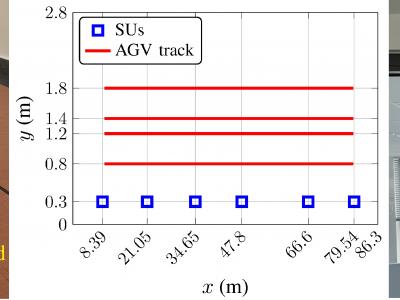Received Signal Strength
Accurately obtaining the position of active transmitters within an indoor wireless network has promising applications in future wireless networks. However, due to the complex propagation phenomena experienced by signals indoors, classical model-based localization techniques present poor accuracy, and machine learning (ML) based positioning has a promising potential to deliver high accuracy localization services indoors.
- Categories:
 173 Views
173 ViewsA reasonable approach to cope with increasing car traffic is the application of large-scale car traffic management solutions. Dense and widely applied car traffic monitoring is an important key prerequisite for this.
Established solutions like e.g. induction loops, video-camera-based systems, or radar, do not suit all the needs with regard to installation effort, privacy, and cost efficiency.
- Categories:
 831 Views
831 Views
Visible Light Positioning is an indoor localization technology that uses wireless transmission of visible light signals to obtain a location estimate of a mobile receiver.
This dataset can be used to validate supervised machine learning approaches in the context of Received Signal Strength Based Visible Light Positioning.
The set is acquired in an experimental setup that consists of 4 LED transmitter beacons and a photodiode as receiving element that can move in 2D.
- Categories:
 914 Views
914 Views
WiFi measurements dataset for WiFi fingerprint indoor localization compiled on the first and ground floors of the Escuela Técnica Superior de Ingeniería Informática, in Seville, Spain. The facility has 24.000 m² approximately, although only accessible areas were compiled.
- Categories:
 1516 Views
1516 Views
The frequency domain measurement of the scattering parameter, S21, of the wireless channel was carried out using the ZVB14 Vector Network Analyzer (VNA) from Rhode and Schwartz. The measurement system consists of the VNA, low loss RF cables, and omnidirectional antennas at the transmitter and receiver ends. The transmitter and receiver heights were fixed at 1.5 m. A program script was written for the VNA to measure 10 consecutive sweeps: each sweep contains 601 frequency sample points with spacing of 0.167 MHz to cover a 100 MHz band centered at 2.4 GHz.
- Categories:
 3408 Views
3408 Views
The dataset is an extensive collection of labeled high-frequency Wi-Fi Radio Signal Strength (RSS) measurements corresponding to multiple hand gestures made near a smartphone under different spatial and data traffic scenarios. We open source the software code and an Android app (Winiff) to create this dataset, which is available at Github (https://github.com/mohaseeb/wisture). The dataset is created using an artificial traffic induction (between the phone and the access point) approach to enable useful and meaningful RSS value
- Categories:
 1107 Views
1107 Views
